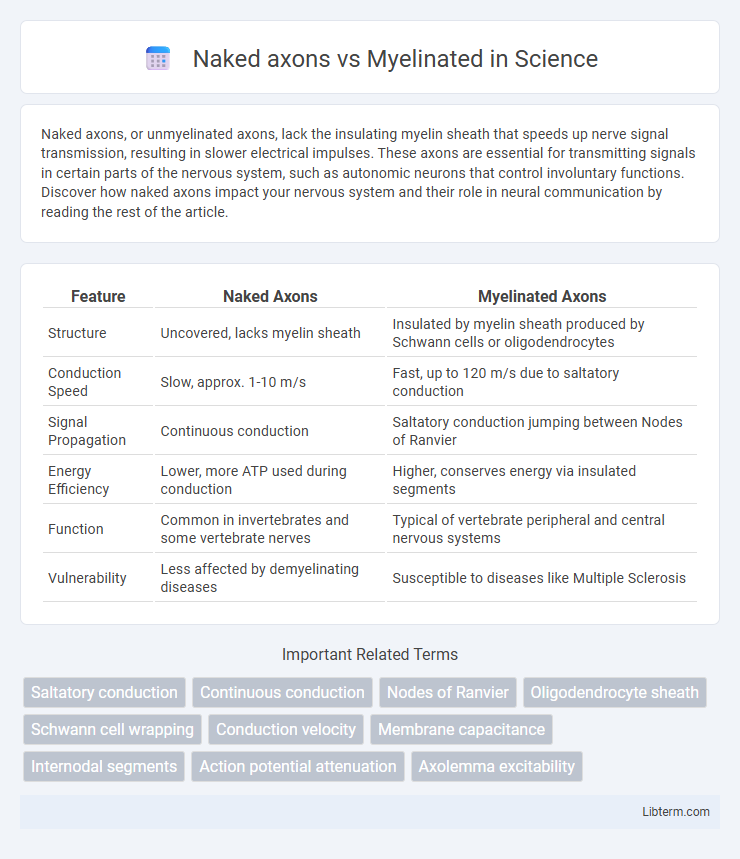Naked axons, or unmyelinated axons, lack the insulating myelin sheath that speeds up nerve signal transmission, resulting in slower electrical impulses. These axons are essential for transmitting signals in certain parts of the nervous system, such as autonomic neurons that control involuntary functions. Discover how naked axons impact your nervous system and their role in neural communication by reading the rest of the article.
Table of Comparison
| Feature | Naked Axons | Myelinated Axons |
|---|---|---|
| Structure | Uncovered, lacks myelin sheath | Insulated by myelin sheath produced by Schwann cells or oligodendrocytes |
| Conduction Speed | Slow, approx. 1-10 m/s | Fast, up to 120 m/s due to saltatory conduction |
| Signal Propagation | Continuous conduction | Saltatory conduction jumping between Nodes of Ranvier |
| Energy Efficiency | Lower, more ATP used during conduction | Higher, conserves energy via insulated segments |
| Function | Common in invertebrates and some vertebrate nerves | Typical of vertebrate peripheral and central nervous systems |
| Vulnerability | Less affected by demyelinating diseases | Susceptible to diseases like Multiple Sclerosis |
Introduction to Axons: Naked vs. Myelinated
Axons are nerve fibers responsible for transmitting electrical signals within the nervous system, categorized into naked (unmyelinated) and myelinated types. Naked axons lack the insulating myelin sheath, resulting in slower signal conduction, whereas myelinated axons are wrapped in layers of myelin produced by glial cells, significantly enhancing the speed and efficiency of impulse transmission. The myelin sheath also aids in protecting axons and facilitating saltatory conduction, where electrical impulses jump between nodes of Ranvier, boosting neural communication efficiency.
Structural Differences Between Naked and Myelinated Axons
Naked axons lack the insulating myelin sheath, exposing the axon membrane directly to the extracellular environment, resulting in slower nerve impulse conduction. Myelinated axons feature multiple layers of lipid-rich myelin produced by Schwann cells or oligodendrocytes, which increase conduction velocity via saltatory conduction at the nodes of Ranvier. The structural distinction lies in the presence or absence of the myelin sheath, dramatically impacting signal transmission efficiency and neural function.
Myelination: Composition and Biological Role
Myelination involves the formation of a lipid-rich sheath composed primarily of cholesterol, phospholipids, and proteins such as myelin basic protein (MBP) and proteolipid protein (PLP) that insulates axons to enhance the speed and efficiency of electrical impulse conduction. This biological process is critical in the central and peripheral nervous systems, where myelinated axons enable rapid saltatory conduction, reducing signal transmission time compared to naked axons. The myelin sheath also provides metabolic support and protection to neurons, maintaining axonal integrity and facilitating neural network function.
Naked Axons: Characteristics and Functionality
Naked axons, also known as unmyelinated axons, lack the insulating myelin sheath found in myelinated neurons, resulting in slower signal conduction due to continuous propagation of action potentials along the axon membrane. These axons typically support slower, long-lasting signals and are commonly found in autonomic nervous system fibers and certain sensory neurons. Their primary functionality involves transmitting impulses over short distances where speed is less critical, enabling regulation of functions such as visceral organ control and pain perception.
Speed of Nerve Impulse Transmission
Naked axons transmit nerve impulses slower due to the continuous conduction along the entire axon membrane, resulting in increased time for action potential propagation. In contrast, myelinated axons exhibit faster nerve impulse transmission through saltatory conduction, where action potentials jump between Nodes of Ranvier, significantly enhancing conduction velocity. This difference in speed is critical for rapid signal processing and efficient communication within the nervous system.
Energy Efficiency in Neural Signaling
Naked axons consume more energy during neural signaling due to continuous action potential propagation along the entire membrane, increasing ion exchange and ATP use for ion pumps. Myelinated axons exhibit greater energy efficiency by enabling saltatory conduction, where action potentials jump between nodes of Ranvier, reducing membrane depolarization and limiting ion flow. This insulation significantly decreases metabolic demands, optimizing energy consumption in rapid and long-distance neural communication.
Vulnerability to Damage: Naked vs. Myelinated Axons
Naked axons, lacking the protective myelin sheath, exhibit higher vulnerability to mechanical injury and neurotoxic damage due to direct exposure to the extracellular environment. Myelinated axons benefit from insulation provided by the myelin sheath, which enhances signal conduction speed and offers protection against physical and chemical insults. Damage to myelinated axons often results in more severe functional deficits due to the critical role of myelin in nerve impulse propagation.
Role in Nervous System Disorders
Naked axons, lacking the insulating myelin sheath, exhibit slower signal conduction and increased susceptibility to damage, contributing to nervous system disorders such as multiple sclerosis (MS) where demyelination impairs neural communication. Myelinated axons facilitate rapid action potential propagation via saltatory conduction, crucial for efficient neural network function; disruptions in myelin integrity are central to diseases like Guillain-Barre syndrome and leukodystrophies. Therapeutic strategies targeting remyelination and axonal protection aim to restore nervous system function and mitigate progression in demyelinating disorders.
Evolutionary Significance of Myelination
Myelination significantly enhances nerve impulse conduction speed and energy efficiency, allowing for rapid and precise communication within complex nervous systems. Evolutionarily, myelinated axons enabled vertebrates to develop advanced motor control and cognitive functions, supporting greater survival adaptability. In contrast, naked axons, typical of primitive organisms, exhibit slower signal transmission and limited functional complexity.
Future Research and Clinical Implications
Future research on naked axons versus myelinated axons emphasizes the exploration of axonal conduction velocity and energy efficiency, aiming to better understand neurological disease mechanisms such as multiple sclerosis. Clinical implications include developing targeted therapies that promote remyelination or protect naked axons to restore nerve function and prevent neurodegeneration. Advancements in imaging techniques and molecular biology will enhance the precision of diagnosis and intervention strategies in demyelinating disorders.
Naked axons Infographic

 libterm.com
libterm.com